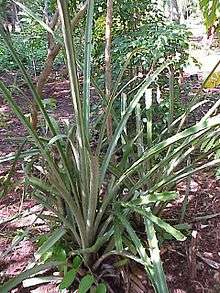Bromelia
Bromelia is the type genus of the plant family Bromeliaceae, subfamily Bromelioideae. Bromelia species are widespread across much of Latin America and the West Indies,[1] and are characterized by flowers with a deeply cleft calyx. The genus is named after the Swedish medical doctor and botanist Olof Bromelius (1639-1705).
| Bromelia | |
|---|---|
 | |
| Bromelia karatas | |
| Scientific classification | |
| Kingdom: | Plantae |
| Clade: | Tracheophytes |
| Clade: | Angiosperms |
| Clade: | Monocots |
| Clade: | Commelinids |
| Order: | Poales |
| Family: | Bromeliaceae |
| Subfamily: | Bromelioideae |
| Genus: | Bromelia L. |
| Synonyms[1] | |
| |
The type species is B. karatas.
Species
- Bromelia agavifolia Brongniart ex Houllet - French Guiana
- Bromelia alsodes H. St. John - from Sinaloa south to Nicaragua
- Bromelia alta L.B. Smith - Guyana and Suriname
- Bromelia antiacantha Bertoloni - Brazil, Uruguay
- Bromelia araujoi P.J.Braun, Esteves & Scharf - Maranhão
- Bromelia arenaria Ule - Bahia
- Bromelia arubaiensis P.L. Ibisch & R. Vásquez - Bolivia
- Bromelia auriculata L.B. Smith - Ceará
- Bromelia balansae Mez - Brazil, Colombia, Bolivia, Argentina, Paraguay
- Bromelia binotii E. Morren ex Mez - Espírito Santo
- Bromelia braunii Leme & E. Esteves - Tocantins
- Bromelia charlesii P.J.Braun, Esteves & Scharf - Bahia
- Bromelia chrysantha Jacquin - Venezuela, Colombia, Trinidad & Tobago
- Bromelia dilatata Esteves, Hofacker & Scharf - Mato Grosso
- Bromelia eitenorum L.B. Smith - Maranhão
- Bromelia epiphytica L.B. Smith - Amazonas of Brazil
- Bromelia estevesii Leme - Piauí
- Bromelia exigua Mez - Goiás
- Bromelia flemingii I. Ramírez & Carnevali - Aragua of Veenzuela
- Bromelia fosteriana L.B. Smith - Suriname
- Bromelia fragilis L.B. Smith - Colombia
- Bromelia glaziovii Mez - Minas Gerais and Goiás
- Bromelia goeldiana L.B. Smith - Venezuela and Brazil
- Bromelia goyazensis Mez - Goiás
- Bromelia grandiflora Mez - Brazil
- Bromelia granvillei L.B. Smith & Gouda - French Guiana
- Bromelia gurkeniana E. Pereira & Moutinho
- var. funchiana E. Pereira & Leme -Bahia
- var. gurkeniana - Pará
- Bromelia hemisphaerica Lam. - from Guanajuato south to Panama
- Bromelia hieronymi Mez - Bolivia, Paraguay, Argentina
- Bromelia horstii Rauh - Mato Grosso
- Bromelia humilis Jacquin - Venezuela, Trinidad & Tobago, Netherlands Antilles
- Bromelia ignaciana R. Vásquez & P.L. Ibisch - Bolivia
- Bromelia interior L.B. Smith - Brazil
- Bromelia irwinii L.B. Smith - Goiás
- Bromelia karatas Linnaeus - West Indies; Latin America from San Luis Potosí + Sinaloa south to Brazil
- Bromelia laciniosa Martius ex Schultes f. - Brazil + Argentina
- Bromelia lagopus Mez - Brazil
- Bromelia legrellae (E. Morren) Mez - Pará
- Bromelia lindevaldae Leme & E. Esteves - Bahia
- Bromelia macedoi L.B. Smith - Goiás
- Bromelia michaelii Esteves, Hofacker & Scharf - Goiás
- Bromelia minima Leme & E. Esteves - Goiás
- Bromelia morreniana (Regel) Mez - northern Brazil
- Bromelia nidus-puellae (André) André ex Mez - Colombia
- Bromelia oliveirae L.B. Smith - Pará
- Bromelia palmeri Mez - from Colima south to Oaxaca
- Bromelia pinguin Linnaeus - West Indies; from Mexico to Ecuador and Suriname; naturalized in Florida
- Bromelia poeppigii Mez - Peru
- Bromelia redoutei (Baker) L.B. Smith - described 1889; origin unknown; probably extinct
- Bromelia regnellii Mez - Brazil
- Bromelia reversacantha Mez - Goiás
- Bromelia rondoniana L.B. Smith - Rondônia
- Bromelia scarlatina (hortus ex Hérincq) E. Morren - Ecuador + Brazil
- Bromelia serra Grisebach - Brazil, French Guiana, Bolivia, Paraguay, Argentina
- Bromelia superba Mez - Jamaica
- Bromelia sylvicola S. Moore - Mato Grosso
- Bromelia tarapotina Ule - Peru
- Bromelia trianae Mez - Colombia
- Bromelia tubulosa L.B. Smith - Venezuela + Brazil
- Bromelia unaensis Leme & Scharf - Bahia
- Bromelia urbaniana (Mez) L.B.Sm. - Paraguay + Argentina
- Bromelia villosa Mez - Bolivia + Brazil
| Wikimedia Commons has media related to Bromelia. |
Cultivation and uses
The resistant fiber obtained from B. serra and B. hieronymi, both known as chaguar, is an essential component of the economy of the Wichí tribe in the semi-arid Gran Chaco region of Argentina. An 1841 publication described the fiber of silk grass (Bromelia karata) as "equal in durability to our best bowstrings."[2]
gollark: > Two generations ago, scientists took a biopsy of a tumor from a cancer patient named Elizabeth Gratwick, who died soon after. Without her knowledge or consent, these cells were preserved in the laboratory and proved to be exceptionally stable in replication. As stable cancer cell lines are highly useful for medical research, “ElGr cells” have been sent to and used by scientists all over the world. However, objections are now being raised by Elizabeth’s descendants.
gollark: Now I need to answer a question!
gollark: And top 1% for crime.
gollark: * 0.8%
gollark: It's actually top 0.8 in the world for rudeness!
References
- Kew World Checklist of Selected Plant Families
- Sir Robert Hermann Schomburgk; Sir William Jardine; Andrew Crichton (1841). The Natural History of the Fishes of Guiana. W. H. Lizars. p. 102.
External links
This article is issued from Wikipedia. The text is licensed under Creative Commons - Attribution - Sharealike. Additional terms may apply for the media files.